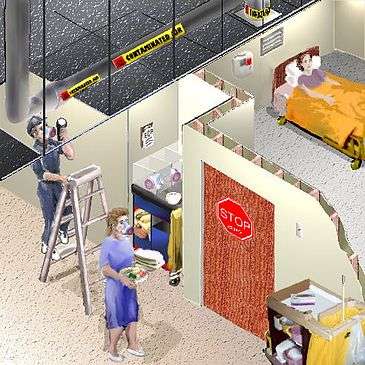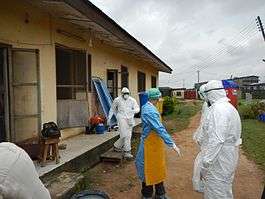Isolation (health care)

In health care facilities, isolation represents one of several measures that can be taken to implement infection control: the prevention of contagious diseases from being spread from a patient to other patients, health care workers, and visitors, or from outsiders to a particular patient (reverse isolation). Various forms of isolation exist, in some of which contact procedures are modified, and others in which the patient is kept away from all others. In a system devised, and periodically revised, by the U.S. Centers for Disease Control and Prevention (CDC), various levels of patient isolation comprise application of one or more formally described "precaution".
Isolation is most commonly used when a patient is known to have a contagious (transmissible person-to-person) viral or bacterial illness.[1] Special equipment is used in the management of patients in the various forms of isolation. These most commonly include items of personal protective equipment (gowns, masks, and gloves) and engineering controls (positive pressure rooms, negative pressure rooms, laminar air flow equipment, and various mechanical and structural barriers).[2] Dedicated isolation wards may be pre-built into hospitals, or isolation units may be temporarily designated in facilities in the midst of an epidemic emergency.
Definitions
Isolation is defined as the voluntary or compulsory separation and confinement of those known or suspected to be infected with a contagious disease agent (whether ill or not) to prevent further infections. (In this form of isolation, transmission-based precautions are imposed.) In contrast, quarantine is the compulsory separation and confinement, with restriction of movement, of healthy individuals or groups who have potentially been exposed to an agent to prevent further infections should infection occur. Biocontainment refers to laboratory biosafety in microbiology laboratories in which the physical containment (BSL-3, BSL-4) of highly pathogenic organisms is accomplished through built-in engineering controls.
Types of precautions
Universal/standard precautions
Universal precautions refer to the practice, in medicine, of avoiding contact with patients' bodily fluids, by means of the wearing of nonporous articles such as medical gloves, goggles, and face shields. The practice was widely introduced in 1985–88.[3][4] In 1987, the practice of universal precautions was adjusted by a set of rules known as body substance isolation. In 1996, both practices were replaced by the latest approach known as standard precautions. Use of personal protective equipment is now recommended in all health settings.
Transmission-based precautions
Transmission-based precautions are additional infection control precautions — over and above universal/standard precautions — and the latest routine infection prevention and control practices applied for patients who are known or suspected to be infected or colonized with infectious agents, including certain epidemiologically important pathogens. The latter require additional control measures to effectively prevent transmission.[5][6]
There are three types of transmission-based precaution:
- Contact precautions are intended to prevent transmission of infectious agents, including epidemiologically important microorganisms, which are spread by direct or indirect contact with the patient or the patient’s environment.
- Droplet precautions are intended to prevent transmission of pathogens spread through close respiratory or mucous membrane contact with respiratory secretions.
- Airborne precautions prevent transmission of infectious agents that remain infectious over long distances when suspended in the air (e.g., rubeola virus [measles], varicella virus [chickenpox], M. tuberculosis, and possibly SARS-CoV).
Forms of isolation
Strict isolation
Strict isolation is used for diseases spread through the air and in some cases by contact.[2] Patients must be placed in isolation to prevent the spread of infectious diseases.[7] Those who are kept in strict isolation are often kept in a special room at the facility designed for that purpose. Such rooms are equipped with a special lavatory and caregiving equipment, and a sink and waste disposal are provided for workers upon leaving the area.[8]
Contact isolation
Contact isolation is used to prevent the spread of diseases that can be spread through contact with open wounds. Health care workers making contact with a patient on contact isolation are required to wear gloves, and in some cases, a gown.
Respiratory isolation
Respiratory isolation is used for diseases that are spread through particles that are exhaled.[2] Those having contact with or exposure to such a patient are required to wear a mask.
Reverse isolation
Reverse isolation is a way to prevent a patient in a compromised health situation from being contaminated by other people or objects. It often involves the use of laminar air flow and mechanical barriers (to avoid physical contact with others) to isolate the patient from any harmful pathogens present in the external environment.[9]
High isolation
.jpg)
High isolation is used to prevent the spread of unusually highly contagious, or high consequence, infectious diseases (e.g., smallpox, Ebola virus). It stipulates mandatory use of: (1) gloves (or double gloves if appropriate), (2) protective eyewear (goggles or face shield), (3) a waterproof gown (or total body Tyvek suit, if appropriate), and (4) a respirator (at least FFP2 or N95 NIOSH equivalent), not simply a surgical mask.[10] Sometimes negative pressure rooms or powered air-purifying respirators (PAPRs) are also used.
Effects of isolation
Isolation can have the following negative effects on patients and staff:
- Patient may not be able to receive visitors, and in turn, become lonely
- Patient may be anxious
- Small children may feel their isolation is a punishment[11]
- Staff may need to spend more time with patients
- Patients may not be able to receive certain types of care due to the risk that other patients may become contaminated. This includes forms of care that involve use of equipment common to all patients at the facility, or that involve transporting the patient to an area of the facility common to all patients.
Diseased workers

Health care workers who become infected with certain contagious agents may not be permitted to work with patients for a period of time. While facility rules and laws vary from place to place, a common guideline that has been set is 48 hours of removal.[8] Technically, however, this form of infection control is not considered "isolation".
See also
References
- ↑ Lawrence J; May D (2003). Infection control in the community. Elsevier Health Sciences. p. 136. ISBN 978-0-443-06406-7.
- 1 2 3 Uys LR (1999). Fundamental nursing. Pearson South Africa. p. 249. ISBN 978-0-636-04208-7.
- ↑ CDC. Update: universal precautions for prevention of transmission of human immunodeficiency virus, hepatitis B virus, and other bloodborne pathogens in health-care settings. MMWR Morb Mortal Wkly Rep 1988;37(24):377-82, 87–8.
- ↑ CDC. Recommendations for preventing transmission of infection with human T- lymphotropic virus type III/lymphadenopathy-associated virus in the workplace. MMWR Morb Mortal Wkly Rep 1985;34(45):681-6, 91–5.
- ↑ Siegel JD, Rhinehart E, Jackson M, Chiarello L, and the Healthcare Infection Control Practices Advisory Committee, 2007 Guideline for Isolation Precautions: Preventing Transmission of Infectious Agents in Healthcare Settings
- ↑ Infection prevention and control of epidemic- and pandemic-prone acute respiratory diseases in health care, WHO Interim Guidelines.2007 p. 53
- ↑ White L (2004). Foundations of nursing. Cengage Learning. p. 757. ISBN 978-1-4018-2692-5.
- 1 2 Lawrence J; Dee May (2003). Infection control in the community. Elsevier Health Sciences. p. 136. ISBN 978-0-443-06406-7.
- ↑ Tamaroff MH, Nir Y, Straker N (1986). "Children reared in a reverse isolation environment: effects on cognitive and emotional development". J. Autism Dev. Disord. 16 (4): 415–424. doi:10.1007/bf01531708.
- ↑ Puro, Vincenzo (2008), “Risk management of febrile respiratory illness in Emergency Departments”; New Microbiologica, 31, 165-173.
- ↑ Atkinson LD; Murray ME (1985). Fundamentals of nursing: a nursing process approach. Macmillan Pub. Co. p. 374. ISBN 978-0-02-304590-5.